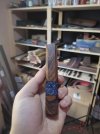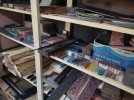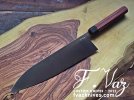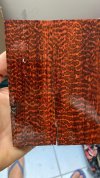- Joined
- Nov 10, 2017
- Messages
- 284
Hey guys! Coming to bring you an amazing knife that i finished last days. For first understanding it, you must see this picture below.
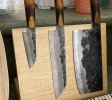
This is a set of honyaki knives i crafted for a customer in New Zealand about 2 years ago. I was surprised that even when i work with mostly exotic woods, he asked me to make the knives with a yellowish simple wood but with a shou sugi ban finish. It took me a while to figure out how i would do that in a "stylish" way, so far, i loved how the charred finish looked like with that "clean" pinch grip facet. After this long while, i decided to make another knife in this style.
One of the hardest challenges for an artisan is to be able to make something excellent out of something common. This is why i absolutely love this style of handle. It is made out of guatambu, a relatively common wood that has a lot of cool features, and one of them is getting burned. While it has around 8,2g/cm³ , it burns nicely and is really permeable by tung oil when hot, one of the reasons why i choosed this for my knives in shou sugi ban finish.
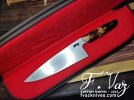
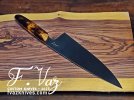
You may already know that japanese like to transform everything into art, so shou sugi ban is not different. It doesnt only look cool, but also offer a few benefits. A good summary of it focused on kitchen knives would be that the burning process create a thin layer of carbon in the wood surface, this layer protects the interior wood in very much the same way that stains or sealantes would but without any chemical involved. It is also a very resistant to moisture damage since the wood become highly permeable and then soaked with tung oil, which penetrates deeply on it.

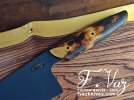
It has 3 carbon fiber pins and an amazing pinch grip facet that is a game changer. It is also perfectly set about half inch before the balance point, which will offer you all the comfort you need for a precise and safe use on it.
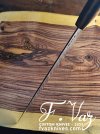

Choil and distal taper speaks by itself. They are both rounded for increased comfort. It has 2,3mm at thickest point, it is really hard to make distal taper on such thin knives but i love challenges. Really thin behind the edge, will slice food like a laser and will sharpen really fast and easy
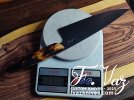
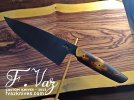
117 grams only for a blade this big. It has 190mm but is quite wide, has 55mm heel to spine and since its full tang, this is a really nice weight. Feels amazing in hand and moves really fast and smooth on the cutting board. Balance perfectly set on the pinch grip area.
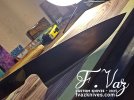
It has a flat edge zone of about 70mm than it does a smooth curve towards the spine. Offers nice action and the blade width is meant to give you a lot of room in order to dont touch your hands in the board. Blade is 1084 steel hardened to 60~61hrc. I love this steel for such thin knives due its similar toughness to 52100.
SOLD - Contact me for ordering one - 200$ shipped with zipped pouch included. Claim via fvazcustomknives@gmail.com (please identify your username here in the forums)
While im new to this forum, i have a ton of international references, mostly based on US.
I love so much shou sugi ban, its very interesting to see how japan culture has developed to create smart techniques to improve their natural lack of resources due being a small island. This heavily affected blacksmithing japanese techniques across the history.
Hope you like it.

This is a set of honyaki knives i crafted for a customer in New Zealand about 2 years ago. I was surprised that even when i work with mostly exotic woods, he asked me to make the knives with a yellowish simple wood but with a shou sugi ban finish. It took me a while to figure out how i would do that in a "stylish" way, so far, i loved how the charred finish looked like with that "clean" pinch grip facet. After this long while, i decided to make another knife in this style.
One of the hardest challenges for an artisan is to be able to make something excellent out of something common. This is why i absolutely love this style of handle. It is made out of guatambu, a relatively common wood that has a lot of cool features, and one of them is getting burned. While it has around 8,2g/cm³ , it burns nicely and is really permeable by tung oil when hot, one of the reasons why i choosed this for my knives in shou sugi ban finish.


You may already know that japanese like to transform everything into art, so shou sugi ban is not different. It doesnt only look cool, but also offer a few benefits. A good summary of it focused on kitchen knives would be that the burning process create a thin layer of carbon in the wood surface, this layer protects the interior wood in very much the same way that stains or sealantes would but without any chemical involved. It is also a very resistant to moisture damage since the wood become highly permeable and then soaked with tung oil, which penetrates deeply on it.


It has 3 carbon fiber pins and an amazing pinch grip facet that is a game changer. It is also perfectly set about half inch before the balance point, which will offer you all the comfort you need for a precise and safe use on it.


Choil and distal taper speaks by itself. They are both rounded for increased comfort. It has 2,3mm at thickest point, it is really hard to make distal taper on such thin knives but i love challenges. Really thin behind the edge, will slice food like a laser and will sharpen really fast and easy


117 grams only for a blade this big. It has 190mm but is quite wide, has 55mm heel to spine and since its full tang, this is a really nice weight. Feels amazing in hand and moves really fast and smooth on the cutting board. Balance perfectly set on the pinch grip area.

It has a flat edge zone of about 70mm than it does a smooth curve towards the spine. Offers nice action and the blade width is meant to give you a lot of room in order to dont touch your hands in the board. Blade is 1084 steel hardened to 60~61hrc. I love this steel for such thin knives due its similar toughness to 52100.
SOLD - Contact me for ordering one - 200$ shipped with zipped pouch included. Claim via fvazcustomknives@gmail.com (please identify your username here in the forums)
While im new to this forum, i have a ton of international references, mostly based on US.
I love so much shou sugi ban, its very interesting to see how japan culture has developed to create smart techniques to improve their natural lack of resources due being a small island. This heavily affected blacksmithing japanese techniques across the history.
Hope you like it.
Last edited:

